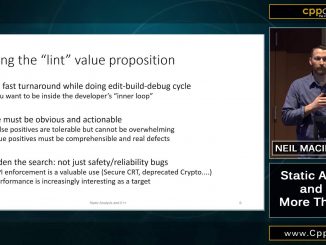Software Testing Videos and Tutorials: Load Testing, Unit Testing, Functional Testing, Performance Testing, Agile Testing, DevOps
Flaky tests are the bugbear of any automated test engineer; as someone once said “insanity is running the same tests over and over again and getting different results”. Flaky tests cause no end of despair, but perhaps there is no such thing as a flaky or non-flaky test, perhaps we need to look at this software testing problem through a different lens.
Let’s forget theory for a moment, and concentrate on the real world test automation. I’ve interviewed over 60 testers and developers on my TestTalks podcast. In this presentation you will discover seven of the most common themes/best practices taken from my guests as well as my own automation experiences. Find out what it takes to succeed with automation awesomeness with actionable advice you can apply right away to your own test automation projects.
Static analysis tools have the potential to significantly improve programmer productivity as well as the safety, reliability and efficiency of the code they write. Modern static analysis has moved well beyond the mental model people often have based on “lint”: just finding simple typos. Static analysis can find subtle, complex bugs early, identify opportunities to improve performance, encourage consistent style and appropriate usage of libraries and APIs.
Software robots, such as Monkey can be used to test Android applications without much manual effort. There are several such tools proposed in academia whose goal is to automatically generate test input to drive Android applications.
The promise of end-to-end (E2E) software testing — complex, real-world test scenarios from the point of view of and end user — is appealing. Many attempts have been made over the years at automating large parts of the software testing and release processes, yet most of these efforts ended up in bitter and hard learned lessons about the inherent challenges of the whole approach.
Your team has just finished a major refactor of a service and all your unit and integration tests pass. Nice work! But you are not done just yet. Now you need to make extra sure that you didn’t break anything and that there are not any lurking bugs that you have not caught yet. It’s time to put Diffy to work.
Writing maintainable test automation code is as important as being able to design good customer-facing systems, yet very few teams do it well. If you think that your test automation often costs too much, takes too long and does not give you the return on investment you expected, this is a talk for you. Learn five key design patterns that will make the pain go away and allow you to get the most out of your automated tests.








